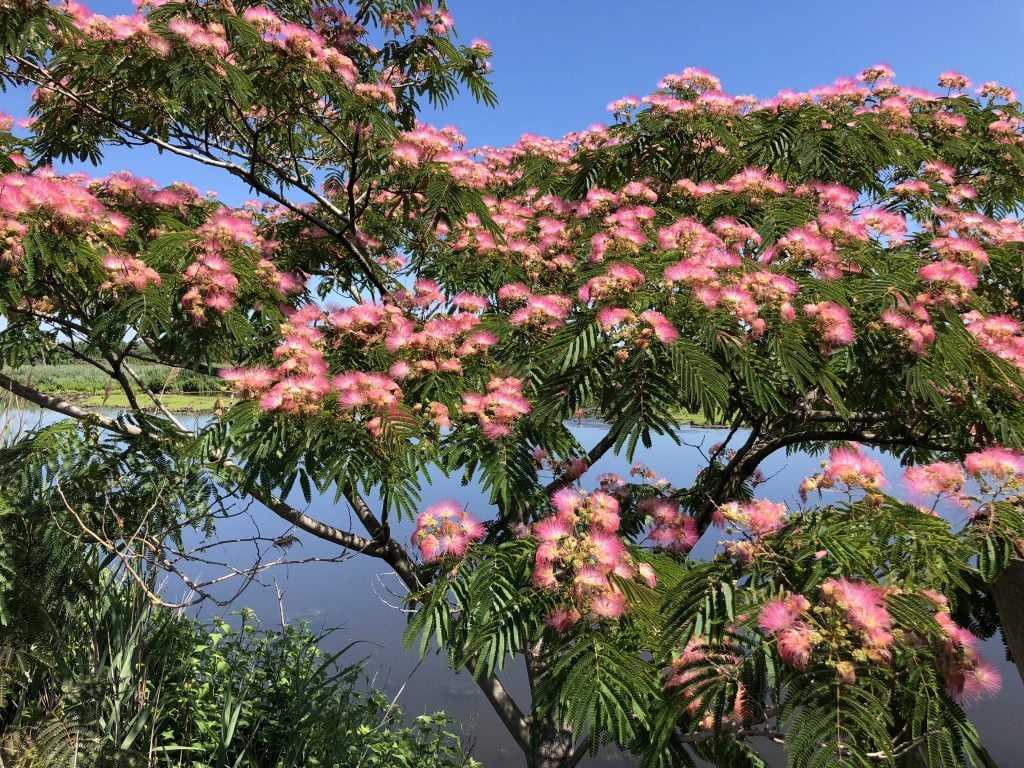Table of Contents
Mimosa trees are native plants to the tropical and subtropical regions, and they receive their name from their unique characteristic wherein they mimic animal behaviour, e.g., if you touch the leaves, they might close up! They are extremely sensitive plants that can be grown as trees, shrubs, herbs, or climbers.
Commonly called mimosa or Persian silk tree, they grow up rapidly and produce bright pink blooms that have a delicate fragrance. It is home to native birds, insects, and bees and can adapt to different types of climates and soil conditions. They are tolerant to pests and diseases as well.
However, these trees are considered invasive and should be examined in depth before being planted because some parts of the tree (seedpods) are toxic to animals like dogs and livestock.
Therefore, let us explore a total of 12 pros and cons of growing these plants!
Characteristics of The Mimosa Tree
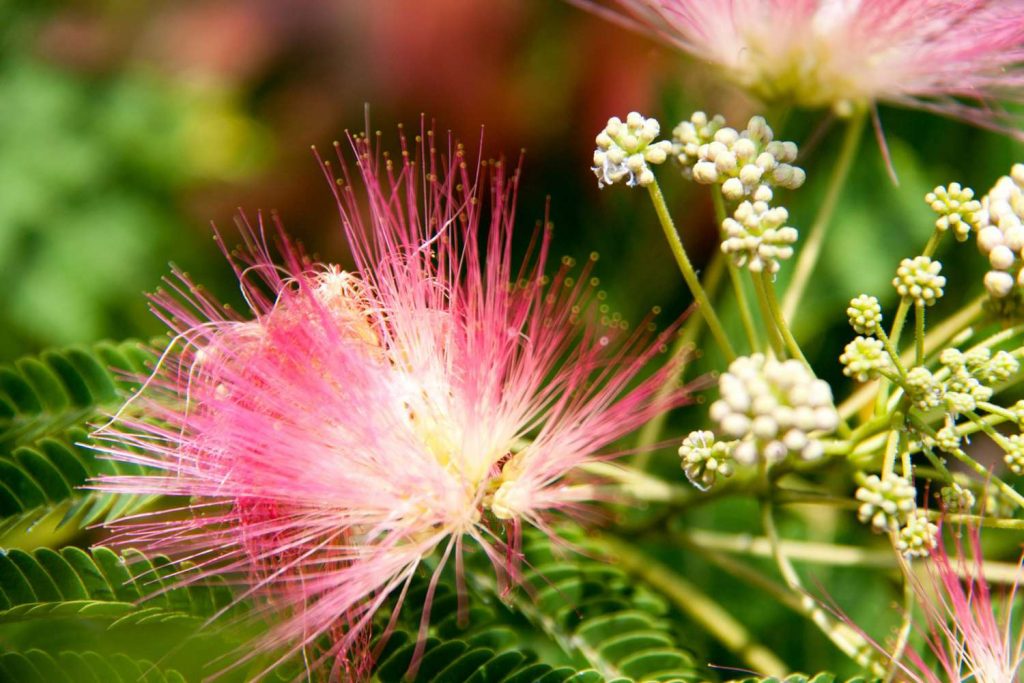
It belongs to the family Fabaceae, and its botanical name is Albizia julibrissin (unique, right?). It can grow up to around 20 to 40 feet in height and 20 to 30 feet in spread. It requires moist soil, which also needs to be well drained. It can be grown in acidic, neutral, or alkaline soil.
In the UK, they may grow best in southern and coastal regions where the winters aren’t harsh. This tree produces beautiful pink blossoms during summer. These trees are highly adaptable and can grow effortlessly, and this is one reason why you see these trees along the side of the highways. The leaves have a fernlike appearance, and the flowers look powdery and soft.
Pros of Growing the Mimosa Tree
1. Nitrogen Fixation
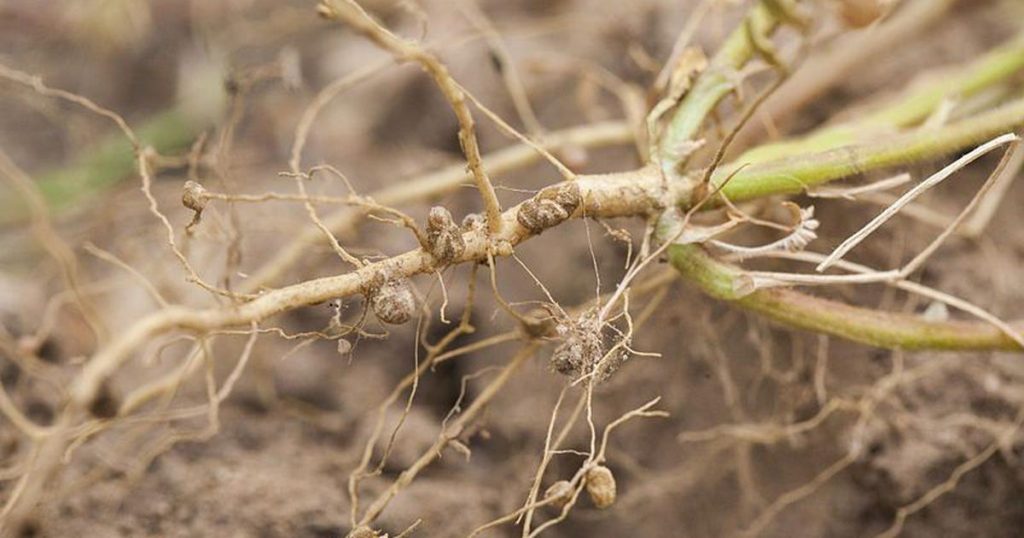
These plants are leguminous, which means that these plants/ trees have nodules or nodes in the roots which contain nitrogen-fixing bacteria called Rhizobium. Therefore, they will alter the level of nitrogen in the soil, usually for the better, as some plants thrive well in such soil. This nitrogen-rich soil might be better suited for growing some plants such as spinach, mustard, lettuce, tomatoes, sweet corn, etc. This might be better for the health of the soil as it does improve the nutritional content of it.
2. Remedy for Soil Erosion
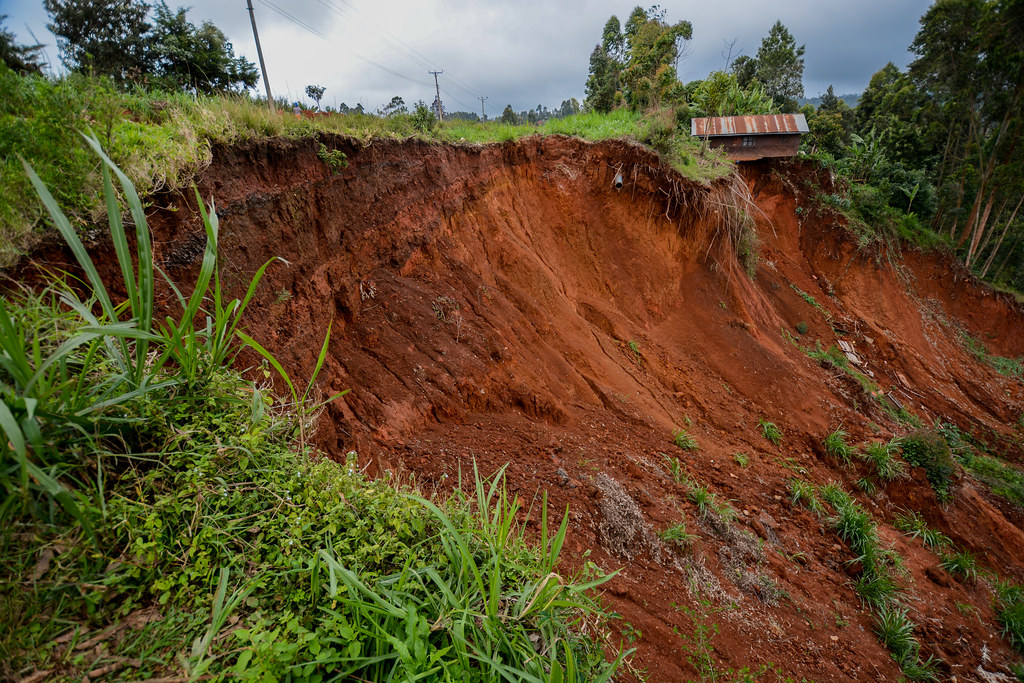
These trees have a strong root system that will prevent the soil from erosion. These roots grow up to 2 feet (around 60cm) deep and so don’t grow them very close to your house and leave around 3 to 6 m around the plant for the roots to explore. These trees can be grown in areas where the soil easily gets eroded, for instance, in places where there is a lot of rainwater rundown. However, it can also be comfortably grown in big containers in your garden.
3. Good Hardiness Level
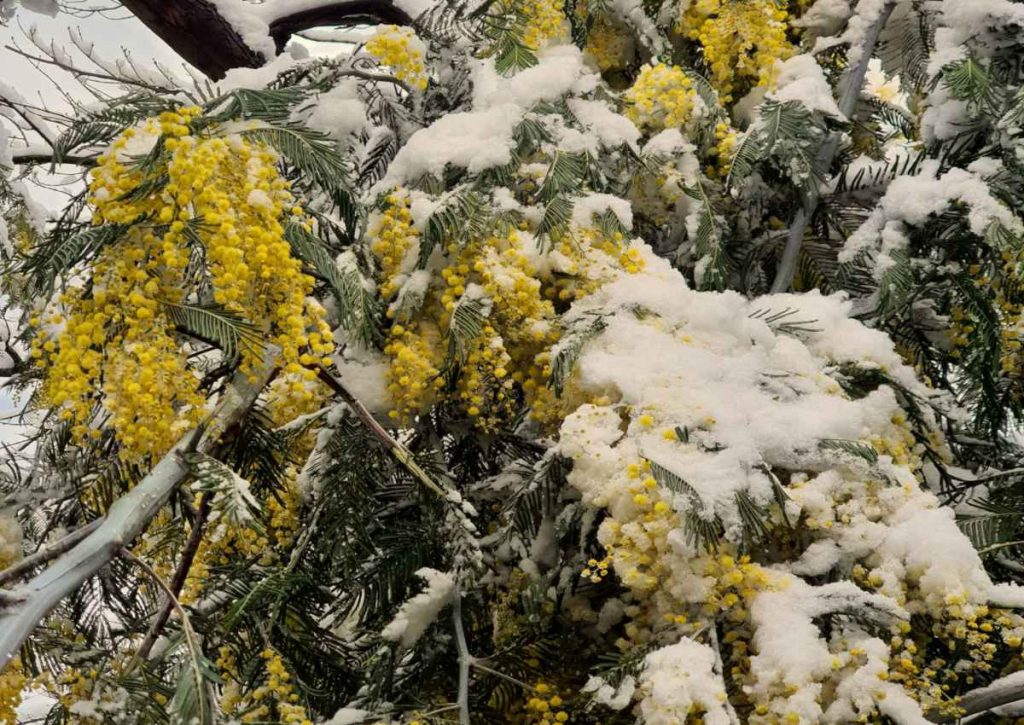
Hardiness refers to a plant’s ability to grow in different weather and soil conditions. They are classified on the basis of the weather conditions they can tolerate and thrive in. If they are hardy, then they might be able to grow in harsh winters in the UK. According to the UK’s Royal Horticultural Society, the hardiness level of the mimosa tree is H3. They can grow well in temperatures of about -5 to 1 degree Celsius.
These trees are considered half-hardy, and they grow well in coastal areas and in places where there is less risk of sudden frost setting in. They may be able to survive in harsh winters with a little bit of protection. However, theoretically, they may have a lower hardiness rating, but in reality, these mimosa trees can grow well in adverse conditions, be it regarding soil, water, or sunlight.
4. Easy to Care For
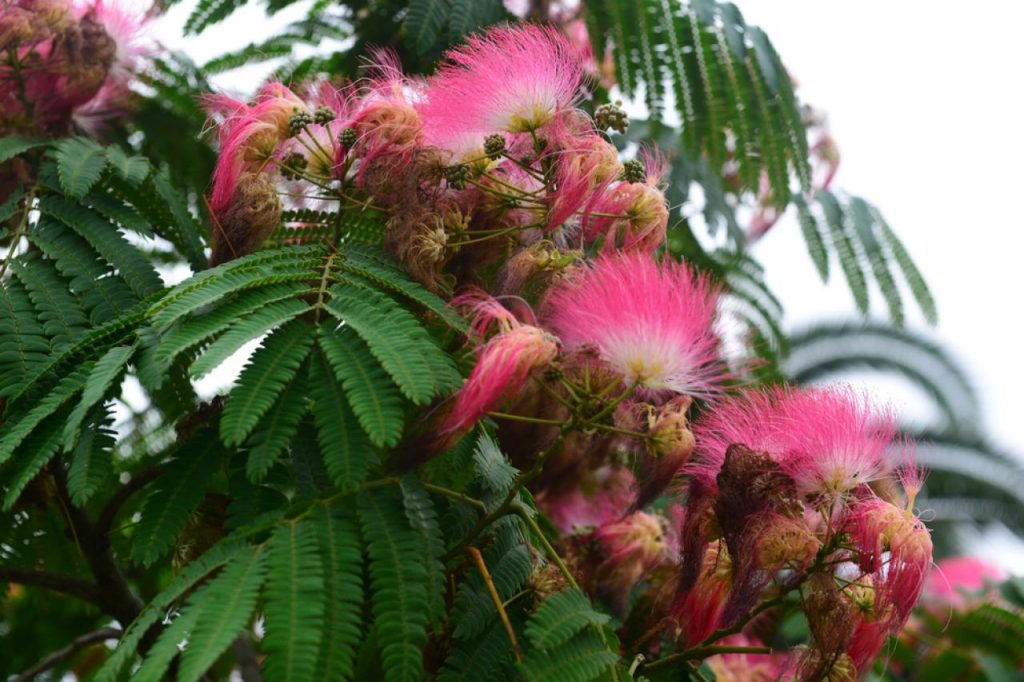
These trees have a good hardiness rating of H3 and can withstand most weather conditions in the UK. they might require a little bit of care during their early days, but once they are established, they can tolerate inadequate water conditions, less exposure to sunlight, soil that is not highly fertile, etc. If ideal conditions are met, they can grow very well, but even if they aren’t there, these trees can adapt and grow well. So even if you don’t have much time to care for these plants in your garden, it is absolutely alright as they will manage well on their own!
5. Aesthetic Attraction in Your Garden
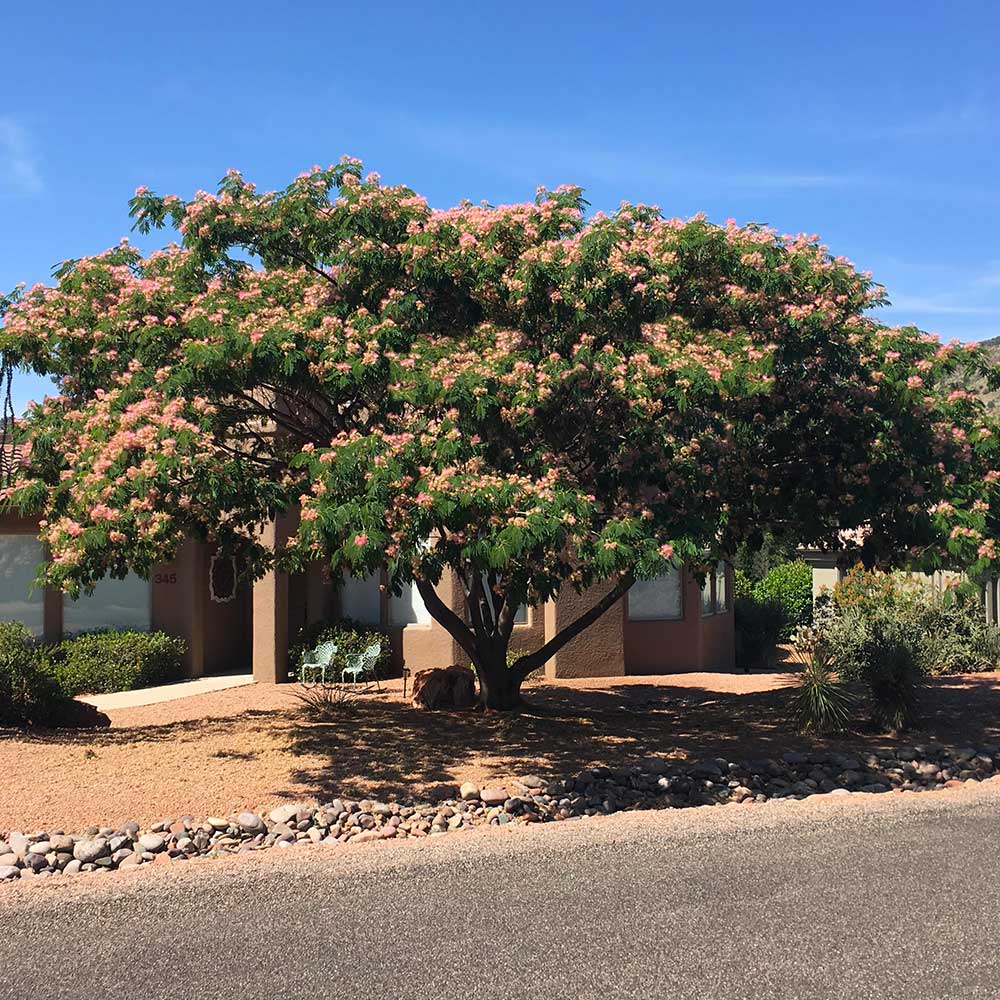
These mimosa trees produce beautiful flowers that are pink and white. They are fragrant and eye-catching, as they look like pompoms growing in clusters. The gradient effect of the flowers makes them extra attractive. These flowers are produced in large numbers in summer and spring and make your garden look spectacular. Since the seed pods easily spread, many mimosa trees might grow in one’s vicinity.
Therefore, it might be a beautiful sight when these trees blossom. The leaves of the tree are no less striking in appearance as they look like ferns which might be around 6 inches (15 cm) long. They also provide good shade for you to rest under. Overall growing a mimosa tree in your garden will be a great aesthetic addition!
6. Home for Several Species
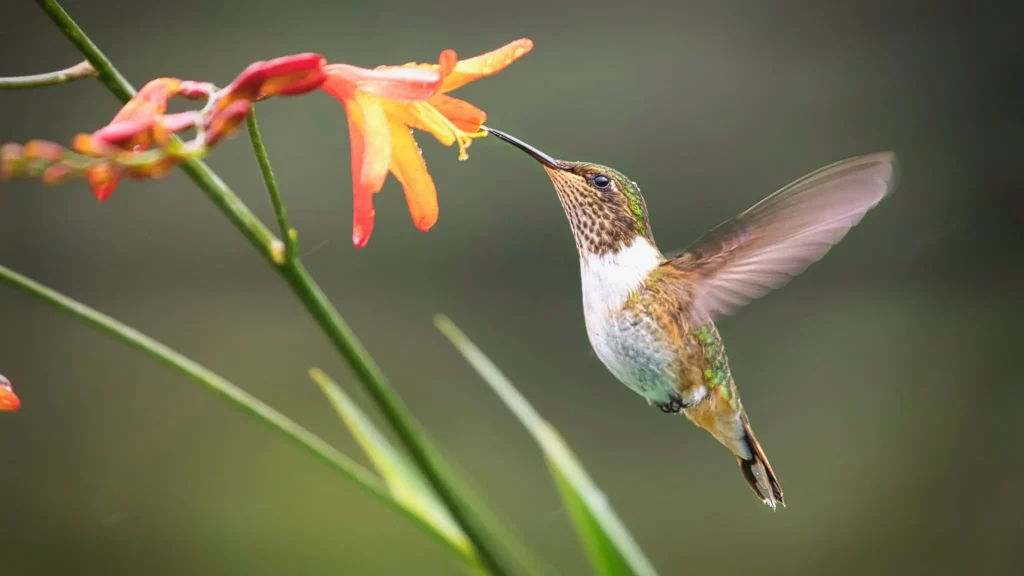
These moderately large mimosa trees are home to bees, hummingbirds, and several insects, especially butterflies. They provide these fauna species with food all around the year and offer them shelter during harsh and cold winters in the UK. These trees also spread their seeds by themselves and don’t need anyone to plant and care for them specifically. As a result, mimosa trees usually grow in number, and this will be more beneficial to species. In addition to the observable species, since these plants are leguminous, their roots are also home to a host of nitrogen-fixing bacteria like Rhizobia. So these trees are home to micro and macro organisms!
Cons of Growing the Mimosa Tree
1. Why Is It Invasive in North America
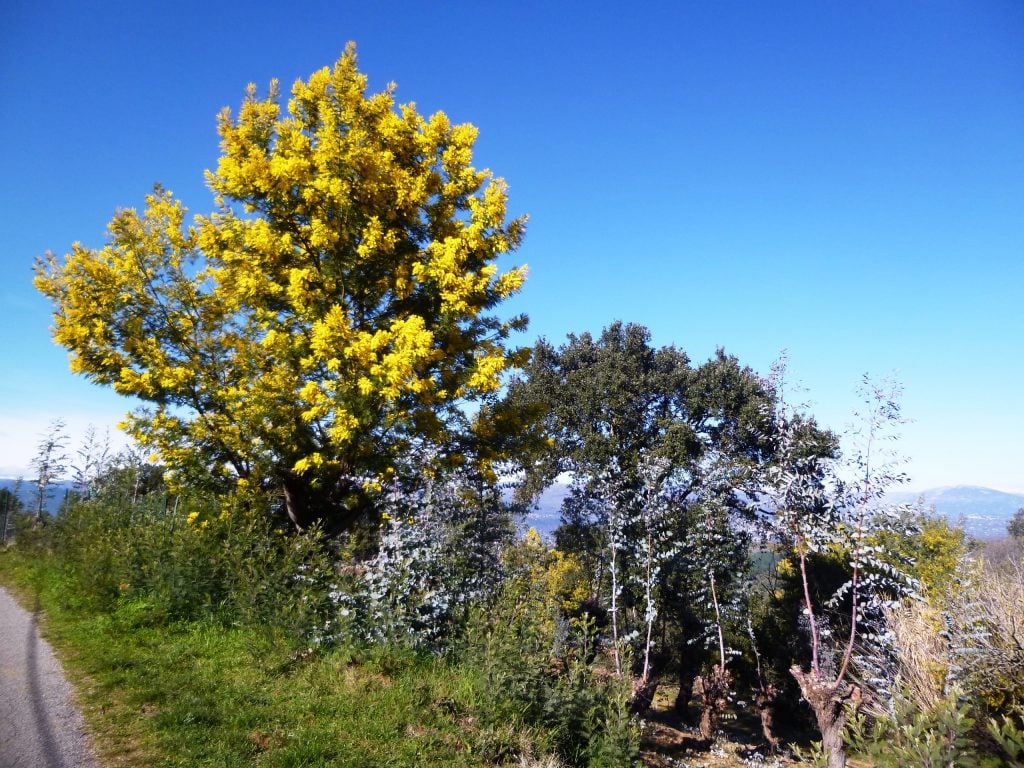
It is labelled an invasive plant because it’s native to Australia, Asia, or the middle east. In different countries, these trees have adapted themselves, and due to their fast growth rate, they compete with native plants for resources like land, nutrients, sunlight, water, etc., and almost prevent these native species from growing.
2. What Happens to the Soil and Ecosystem When You Grow Them
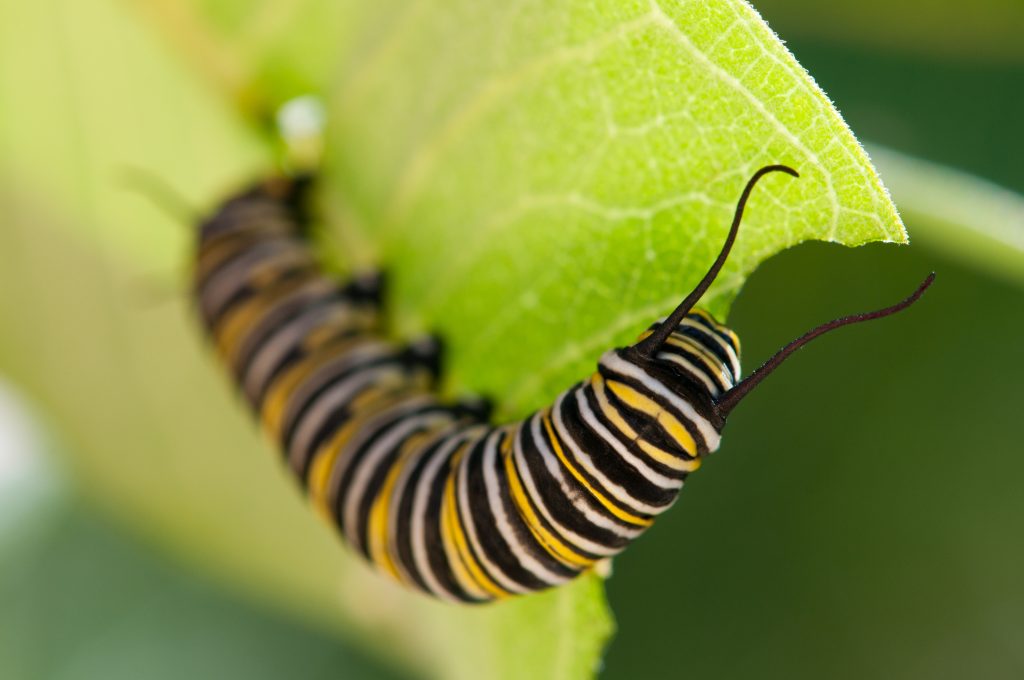
Mimosas fix nitrogen in the soil, as mentioned before, but this doesn’t work out well for some native species because they have adapted themselves to growing in the soil where there is lesser nitrogen. Therefore when they change the nutrient quality of the soil, these native species are greatly affected. These huge trees are home to birds like hummingbirds and attract a host of insects like butterflies to them, and bees also buzz around these flowers for nectar. However, these plants are not native to the UK or the US.
They don’t help many caterpillars or other insects which serve as food for these birds and insects. Therefore, these trees help higher-level creatures like birds and insects but don’t create a sustainable lifestyle because they don’t feed the lower-level organisms.
3. Are There Any Problems with Their Growth
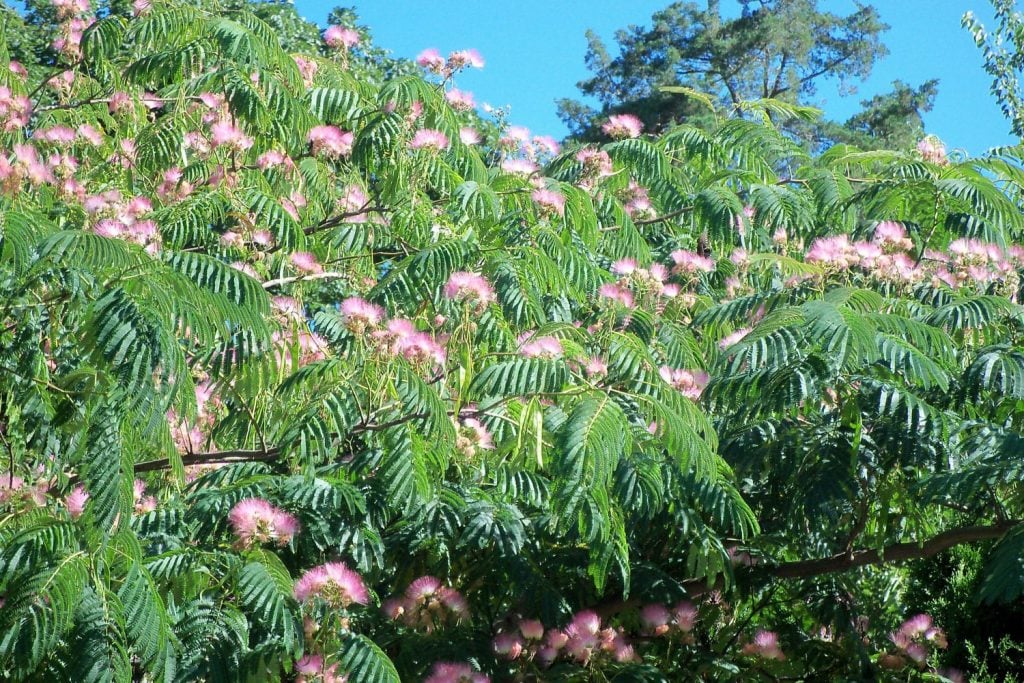
As mentioned before, these trees compete with the native ones for resources. In addition, they have the habit of spreading their flowers, seed pods and leaves far and wide from the tree. This will cause litter in your garden. In addition, these plants are susceptible to a disease called Fusarium wilt that practically kills them completely. However, these trees don’t completely die as new and thicker sprouts of mimosa grow from the roots. This thick and dense growth may be difficult to control in the garden and further causes more competition for other plants in your garden.
4. What Is the Negative Role of Seed Pods
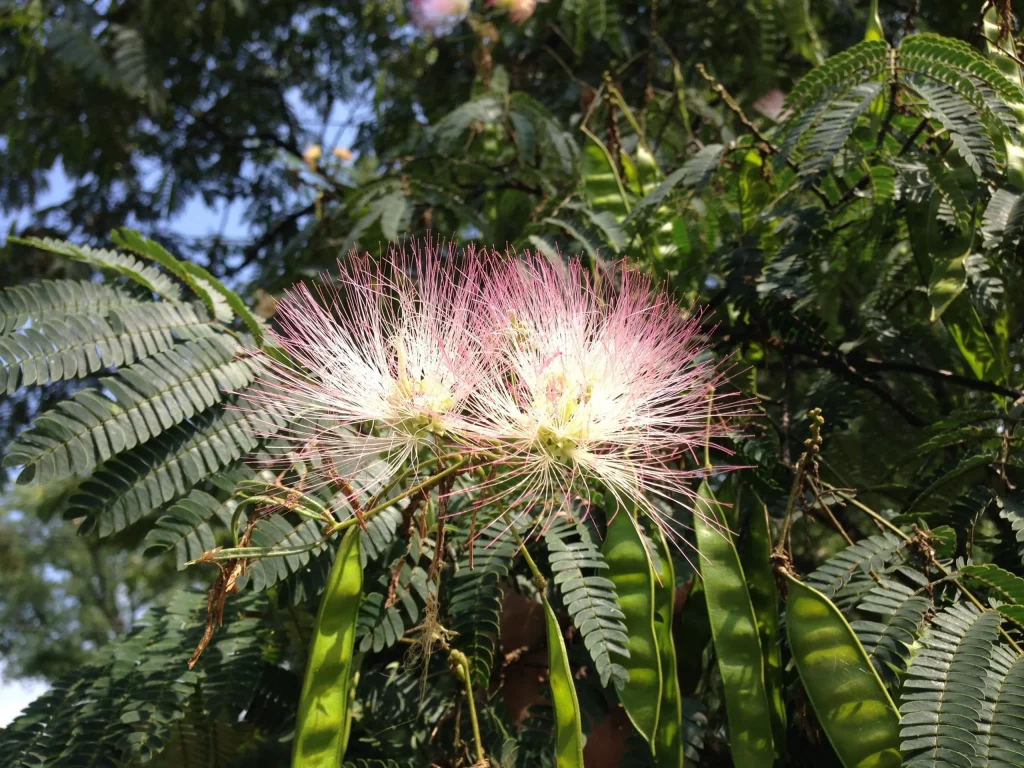
In addition, the seed pods that spread everywhere can easily start growing. Since they can tolerate almost any soil condition other than salty ones, they start growing rapidly as long as they have sun exposure. So it is common to find that mimosa trees are growing in large numbers rather than one or 2. Even if the gardener removes some mimosa trees, nature always wins, and these will start growing rapidly. So think before you plant them, as although you invest in one or two, you will often get many!
5. What Happens to The Dead Leaves and Flowers
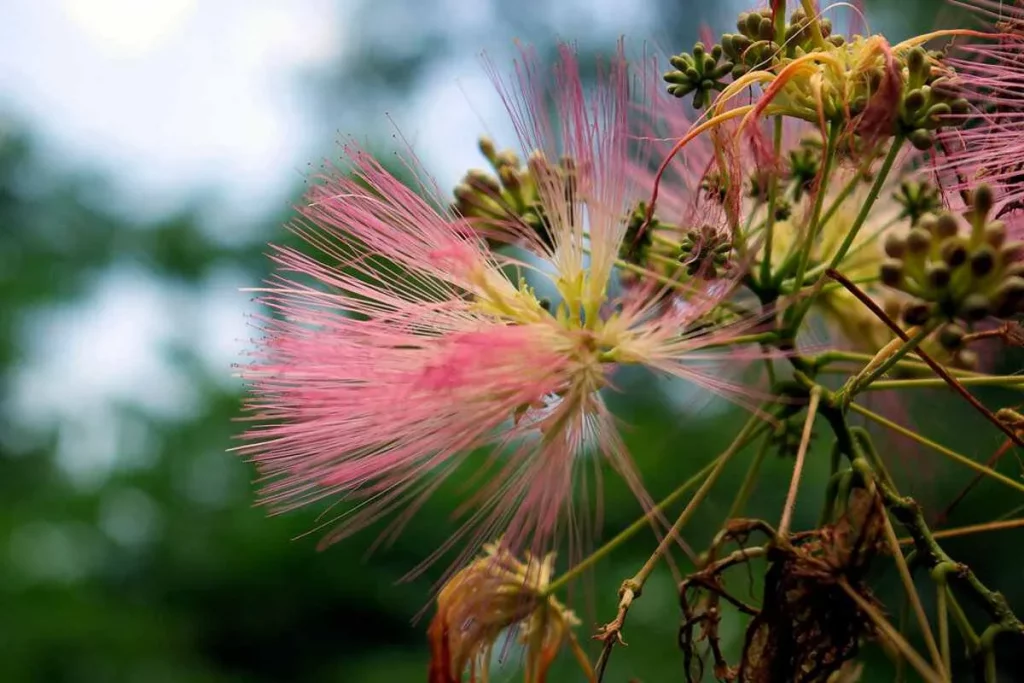
These plants grow and die quickly, especially their flowers. These flowers will be spread everywhere in your garden and quite possibly outside also, and they are susceptible to growing mimosa webworms after they wilt. These are grey-coloured moths that have black spots on the wings, and the adults might have lengthy 13mm wings. These moths and other species can be differentiated by the spots on their wings. These creatures feed on the leaves of these mimosa trees, and therefore, one has to be very careful in planting them. You might have to use artificial pesticides to deal with them.
6. Are Any Parts of Mimosa Trees Toxic
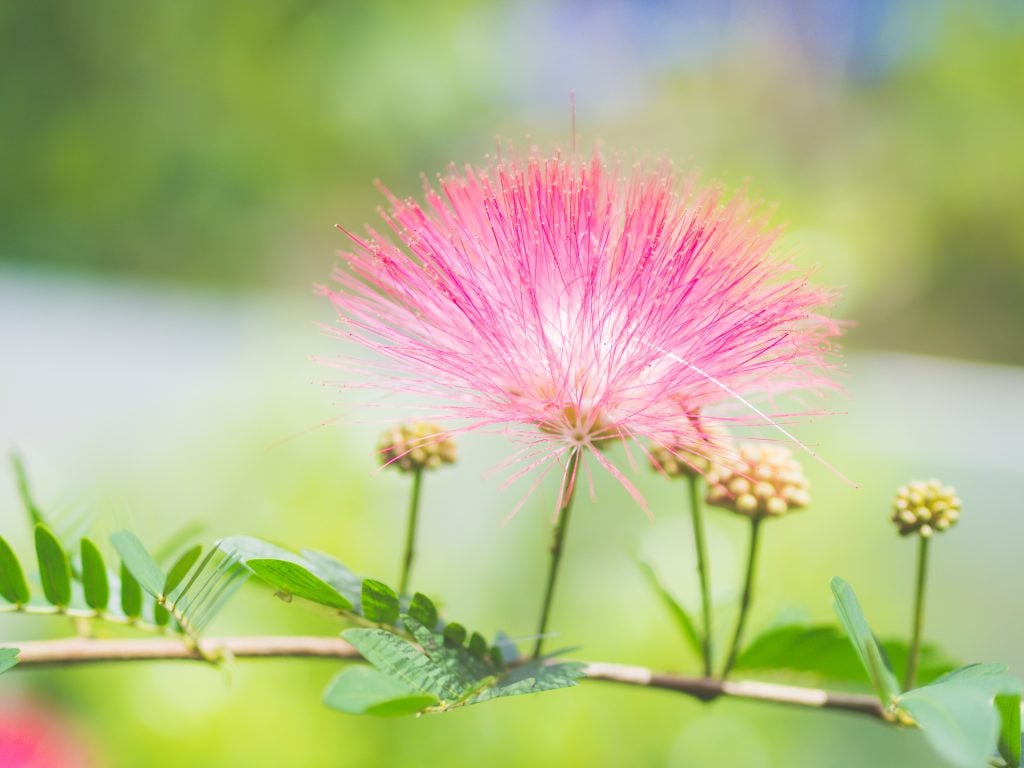
Yes, the seed pods of these trees have about 5 to 10 seeds each. Although they look magnificent with their beautiful pink blossoms, these seeds have a neurotoxin called paralytic shellfish toxins in them. This is very harmful to pets if they are ingested, but the bark and wood don’t have any toxins. These affect livestock like sheep and goats also. The toxicity levels of the mimosa seed pods for humans are not very clear. But in animals, it can cause seizures, tremors, staggering, convulsions, breathing difficulties, etc., after they are ingested. Some studies suggest that these seed pods may even cause the death of animals. This is one reason why it is suggested that animals should be kept away from these trees, although it might be difficult. In children and humans in general, feathery flowers cause breathing difficulties. Since the flowers are mostly spread through the air, it makes these flowers more dangerous.
Summing It Up
These mimosa trees are hardy and can grow in any weather, soil, and watering conditions. They produce beautiful leathery pink and white flowers in summer and have striking fern-like leaves. They attract and provide food and shelter for a number of species like hummingbirds, bees, butterflies, etc. However, they have a list of downsides. They are leguminous and fix nitrogen in the soil, and this might not be ideal for native species of plants. In addition, these trees are classified as invasive as they compete with native species for nutrients and soil.
The flowers, when they wilt, attract moths and worms and produce litter in the garden. They might be toxic to pets and children and cause breathing difficulties also. Therefore, there are a number of pros and cons to growing these striking mimosa trees, and you need to choose carefully based on your needs!
Frequently Asked Questions
What Are Some Reasons for Growing Mimosa Trees?
These trees grow to an ideal height of around 20 to 40 feet and produce beautiful pink flowers that look feathery and appear to have a gradient as well. They provide shade in your garden and are home to a variety of species, don’t need much help and continued care to grow well, and can tolerate a range of adverse weather, soil, and watering conditions. Therefore these are low-maintenance trees that are easy to grow.
Are There Any Downsides to Growing Mimosa Trees?
Unfortunately, these plants do have some negative effects. They are classified as invasive in some places as they compete with native species for nutrition, sunlight, soil, and water requirements. They fix nitrogen in the soil, and these might not be ideal for most native species. The seed pods spread easily, and many mimosa trees grow in a small region. The flowers, when they wilt, attract moths and worms and produce a litter in your garden. So think carefully before growing them!
Do Mimosa Trees Cause Any Health Problems?
Some parts of the tree, such as the feathery flowers, are considered to cause breathing difficulties in children and weak adults. Some parts of the tree are also poisonous and toxic to pets and livestock if they accidentally consume it, as these plants have a neurotoxin that will produce negative consequences. The negative effects of humans consuming it are not clearly researched. But in animals, they may cause seizures, tremors, staggering, convulsions, breathing difficulties, or even death.

